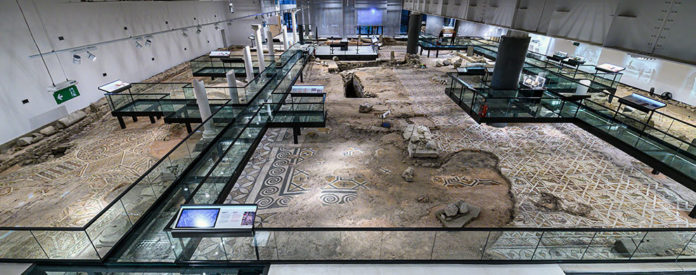A City of Layers, A Basilica of Light
Plovdiv, the city of seven hills, Europe’s oldest continuously inhabited city, is no stranger to history. But even in a city paved with Roman roads and Ottoman courtyards, the Bishop’s Basilica of Philippopolis (The Episcopal Basilica of Philippopolis) feels extraordinary.
Tucked between modern buildings and tram lines just steps from the bustling Central Square, this vast archaeological complex quietly preserves a chapter of Bulgaria’s early Christian soul.
Rediscovered, restored, and reopened in 2021 as a state-of-the-art cultural site, the Bishop’s Basilica is not only one of the most significant early Christian basilicas in the Balkans, but also a storybook in stone and glass. In this place, the Roman Empire, early Christianity, and modern Bulgaria come together in colorful harmony.
Origins: From Roman Philippopolis to Christian Plovdiv
To understand the Basilica, we must go back to the 1st century AD, when Plovdiv was known as Philippopolis, a prosperous Roman provincial city in Thrace. With wide stone streets, aqueducts, amphitheaters, and temples, the city flourished under Roman rule.
By the 4th century, Christianity had taken root across the empire, and Philippopolis became a key episcopal center. The Bishop’s Basilica, built in the mid-4th century, shortly after Emperor Constantine’s Edict of Milan legalized Christianity, stood as both a spiritual stronghold and a symbol of the city’s rising importance.
The site remained in use until the 6th century, when earthquakes, invasions, and shifting power structures led to its abandonment and burial. For centuries, it lay hidden beneath layers of dust, bricks, and memory.
Rediscovery: Unearthing the Jewel Beneath Plovdiv
While the Small Basilica of Plovdiv had been discovered and restored in the 1980s, the Bishop’s Basilica remained forgotten until the early 1980s, when construction work unearthed part of its floor. Full-scale archaeological excavations began in the 2010s, spearheaded by the Plovdiv Archaeological Museum, in partnership with the America for Bulgaria Foundation, which supported the large-scale restoration and exhibition project.
What they found was staggering:
- A basilica measuring 90 x 36 meters, making it among the largest early Christian churches in Southeastern Europe
- Two levels of mosaic floors (some dating to the 4th century, others are later additions)
- A baptistery, apse, narthex, and side aisles, all adorned with artistic detail
In 2021, after a decade of meticulous conservation, the basilica opened to the public—reborn as both a museum and cultural center, featuring high-tech storytelling and preserved beauty.
The Mosaics: Birds, Symbols, and Sacred Geometry
If there is a single reason to visit the Basilica, it’s the mosaics.
Covering over 2,000 square meters, the floor mosaics are a symphony of stone, color, and meaning. Made from tiny tesserae of marble, limestone, and ceramic, the patterns blend geometric elegance with vivid natural imagery, particularly birds.
Over 100 different bird species are depicted—ducks, peacocks, pigeons, cranes, herons, even imaginary birds, many symbolizing the soul, resurrection, or paradise in early Christian iconography. One mosaic shows a peacock drinking from a chalice—a common symbol of eternal life. Another features two doves, wings intertwined, set within a circle of braided lines.
Geometric borders, interlocking rings, and cross-shaped patterns frame the scenes. The result is breathtaking—a sacred visual code that walked the line between art and scripture, theology and decoration.
Even more astonishing, the basilica features two levels of mosaics: the older ones were covered by a second layer, likely during reconstruction in the 5th century. This rare “mosaic sandwich” lets visitors see two centuries of Christian art layered on top of each other—a unique archaeological phenomenon.
A Monument of Bulgarian Identity
Though the Basilica predates the formation of the Bulgarian state, it has become a proud part of Bulgarian heritage. It stands as proof that long before Bulgaria’s official Christianization in 865 AD, the lands of Thrace were already vibrant centers of Christianity.
The Basilica also symbolizes Bulgaria’s role in preserving European heritage—from the Thracians and Romans to Byzantines and modern Slavs. Its careful excavation, conservation, and public presentation are a national achievement, one that merges science, faith, and culture.
In 2020, the site was added to UNESCO’s Tentative List, with strong prospects for full World Heritage status in the coming years.
What to See Today: History Meets High-Tech
The Bishop’s Basilica is now part of Plovdiv’s cultural corridor, easily accessible and housed in a stunning glass-and-steel structure designed to both protect and reveal the past.
Highlights for Visitors:
- Two floors of mosaics, visible through glass walkways and rotating platforms
- Augmented reality screens that reconstruct the basilica as it looked in the 4th century
- Interactive touchscreens that identify each mosaic bird and its symbolic meaning
- Baptismal font, visible in situ with preserved walls
- Exhibition gallery explaining early Christianity in Thrace and Roman Philippopolis
The building itself is a masterclass in modern museology – airy, respectful, and deeply immersive. It’s suitable for families, history lovers, architecture buffs, and spiritual travelers alike.
Plan Your Visit: Practical Info
Address: 1 Tsar Ivan Shishman St., Plovdiv (just south of the Roman Forum) – on the map.
Hours: Tuesday–Sunday, 9:00 – 17:30 (Closed Mondays)
Tickets: ~15 BGN or 7.5 EUR adults, discounts for students, seniors, families
Language: Labels and exhibits available in Bulgarian and English
Tip: Pair your visit with a walk to the Small Basilica (just 10 minutes away), or explore the nearby Roman Stadium and Dzhumaya Mosque for a full plunge into Plovdiv’s cultural layers.



